Improvement of 3D Printing Cement-Based Material Process: Parameter Experiment and Analysis
Abstract
:1. Introduction
2. Materials and Methods
2.1. Materials
2.2. Methods
2.2.1. 3D Cement Printing Equipment
2.2.2. Theory
2.2.3. Experimental Procedure
3. Analysis and Discussion
3.1. Slump Analysis
3.2. Influence of Nozzle Speed and Pressure on Molding Effect
3.3. Influence of Nozzle Offset on Molding Effect
3.4. Effect of Different Pressure on Multi-Nozzle Printing Molding
4. Conclusions
- (1)
- The success of the printed structure depends on the suitability of the properties of the cement-based material. Through strength and slump experiments, the optimal mix ratio suitable for 3D building printer was obtained, which can provide technical support for subsequent experiments.
- (2)
- According to the influencing factors such as nozzle speed, material flow rate and nozzle offset, the theoretical models under different process parameters were analyzed, which can provide theoretical support for the subsequent parameter experiments.
- (3)
- The experimental results show that the theoretical model can fully verify the print structure in different parameter intervals, the layer width and layer height can be controlled by changing the related parameters, which can effectively control the nozzle speed, material flow and nozzle offset to achieve the best effect of cement-based material forming structure.
Author Contributions
Funding
Institutional Review Board Statement
Informed Consent Statement
Data Availability Statement
Acknowledgments
Conflicts of Interest
References
- Hossain, A.; Zhumabekova, A.; Paul, S.; Kim, J. A Review of 3D Printing in Construction and its Impact on the Labor Market. Sustainability 2020, 12, 8492. [Google Scholar] [CrossRef]
- Crosthwaite, D. The global construction market: A cross-sectional analysis. Constr. Manag. Econ. 2000, 18, 619–627. [Google Scholar] [CrossRef]
- Horta, I.; Camanho, A.; Johnes, J.; Johnes, G. Performance trends in the construction industry worldwide: An overview of the turn of the century. J. Prod. Anal. 2013, 39, 89–99. [Google Scholar] [CrossRef]
- Hofmann, E.; Rüsch, M. Industry 4.0 and the current status as well as future prospects on logistics. Comput. Ind. 2017, 89, 23–34. [Google Scholar] [CrossRef]
- Cai, S.; Ma, Z.; Skibniewski, M.J.; Bao, S. Construction automation and robotics for high-rise buildings over the past decades: A comprehensive review. Adv. Eng. Inform. 2019, 42, 100989. [Google Scholar] [CrossRef]
- Bock, T. The future of construction automation: Technological disruption and the upcoming ubiquity of robotics. Autom. Constr. 2015, 59, 113–121. [Google Scholar] [CrossRef]
- Rayna, T.; Striukova, L. From rapid prototyping to home fabrication: How 3D printing is changing business model innovation. Technol. Forecast. Soc. Chang. 2016, 102, 214–224. [Google Scholar] [CrossRef] [Green Version]
- Jayathilakage, R.; Rajeev, P.; Sanjayan, J. Yield stress criteria to assess the buildability of 3D concrete printing. Constr. Build. Mater. 2020, 240, 117989. [Google Scholar] [CrossRef]
- Adaloudis, M.; Roca, J.B. Sustainability tradeoffs in the adoption of 3D Concrete Printing in the construction industry. J. Clean. Prod. 2021, 307, 127201. [Google Scholar] [CrossRef]
- Xiao, J.; Ji, G.; Zhang, Y.; Ma, G.; Mechtcherine, V.; Pan, J.; Wang, L.; Ding, T.; Duan, Z.; Du, S. Large-scale 3D printing concrete technology: Current status and future opportunities. Cem. Concr. Compos. 2021, 122, 104115. [Google Scholar] [CrossRef]
- Zhang, J.; Khoshnevis, B. Optimal machine operation planning for construction by Contour Crafting. Autom. Constr. 2013, 29, 50–67. [Google Scholar] [CrossRef]
- Khoshnevis, B. Automated construction by contour crafting—Related robotics and information technologies. Autom. Constr. 2004, 13, 5–19. [Google Scholar] [CrossRef]
- Cesaretti, G.; Dini, E.; De Kestelier, X.; Colla, V.; Pambaguian, L. Building components for an outpost on the Lunar soil by means of a novel 3D printing technology. Acta Astronaut. 2014, 93, 430–450. [Google Scholar] [CrossRef]
- Lim, S.; Buswell, R.; Le, T.; Austin, S.; Gibb, A.; Thorpe, T. Developments in construction-scale additive manufacturing processes. Autom. Constr. 2012, 21, 262–268. [Google Scholar] [CrossRef] [Green Version]
- Delgado, J.M.D.; Oyedele, L.; Ajayi, A.; Akanbi, L.; Akinade, O.; Bilal, M.; Owolabi, H. Robotics and automated systems in construction: Understanding industry-specific challenges for adoption. J. Build. Eng. 2019, 26, 100868. [Google Scholar] [CrossRef]
- Wu, P.; Wang, J.; Wang, X. A critical review of the use of 3-D printing in the construction industry. Autom. Constr. 2016, 68, 21–31. [Google Scholar] [CrossRef] [Green Version]
- Zhang, J.; Wang, J.; Dong, S.; Yu, X.; Han, B. A review of the current progress and application of 3D printed concrete. Compos. Part A Appl. Sci. Manuf. 2019, 125, 105533. [Google Scholar] [CrossRef]
- Xu, J.; Ding, L.; Love, P.E. Digital reproduction of historical building ornamental components: From 3D scanning to 3D printing. Autom. Constr. 2017, 76, 85–96. [Google Scholar] [CrossRef]
- Gosselin, C.; Duballet, R.; Roux, P.; Gaudillière, N.; Dirrenberger, J.; Morel, P. Large-scale 3D printing of ultra-high performance concrete—A new processing route for architects and builders. Mater. Des. 2016, 100, 102–109. [Google Scholar] [CrossRef] [Green Version]
- Farahbakhsh, M.; Rybkowski, Z.K.; Zakira, U.; Kalantar, N.; Onifade, I. Impact of robotic 3D printing process parameters on interlayer bond strength. Autom. Constr. 2022, 142, 104478. [Google Scholar] [CrossRef]
- Carneau, P.; Mesnil, R.; Baverel, O.; Roussel, N. Layer pressing in concrete extrusion-based 3D-printing: Experiments and analysis. Cem. Concr. Res. 2022, 155, 106741. [Google Scholar] [CrossRef]
- Huang, X.; Yang, W.; Song, F.; Zou, J. Study on the mechanical properties of 3D printing concrete layers and the mechanism of influence of printing parameters. Constr. Build. Mater. 2022, 335, 127496. [Google Scholar] [CrossRef]
- Chen, Y.; Jansen, K.; Zhang, H.; Rodriguez, C.R.; Gan, Y.; Çopuroğlu, O.; Schlangen, E. Effect of printing parameters on interlayer bond strength of 3D printed limestone-calcined clay-based cementitious materials: An experimental and numerical study. Constr. Build. Mater. 2020, 262, 120094. [Google Scholar] [CrossRef]
- Elistratkin, M.; Alfimova, N.; Podgornyi, D.; Olisov, A.; Promakhov, V.; Kozhukhova, N. Influence of Equipment Operation Parameters on the Characteristics of a Track Produced with Construction 3D Printing. Buildings 2022, 12, 593. [Google Scholar] [CrossRef]
- Jayswal, S.D.; Mungule, M. Performance assessment of Alccofine with silica fume, fly ash and slag for development of high strength mortar. Front. Struct. Civ. Eng. 2022, 16, 576–588. [Google Scholar] [CrossRef]
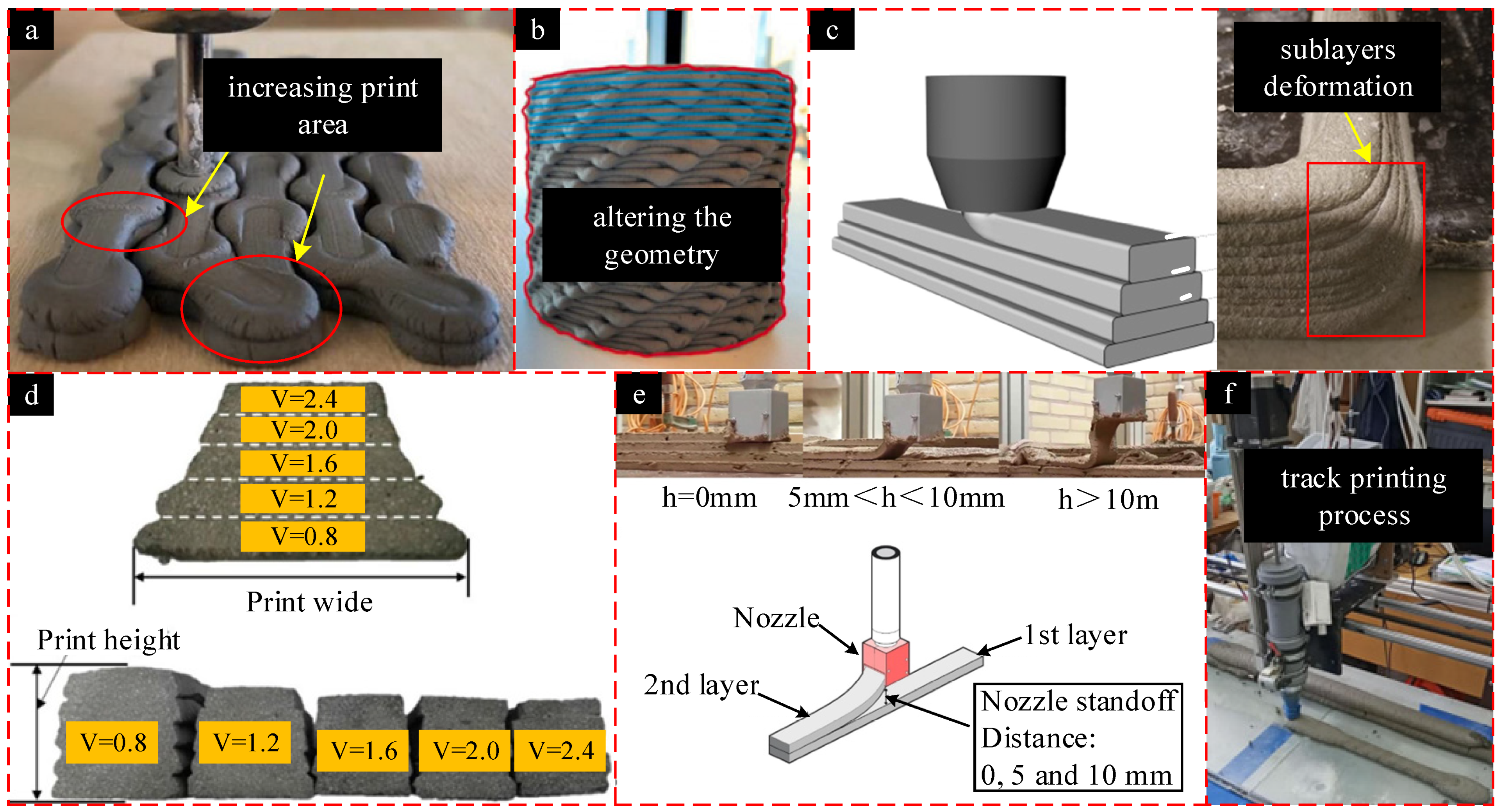

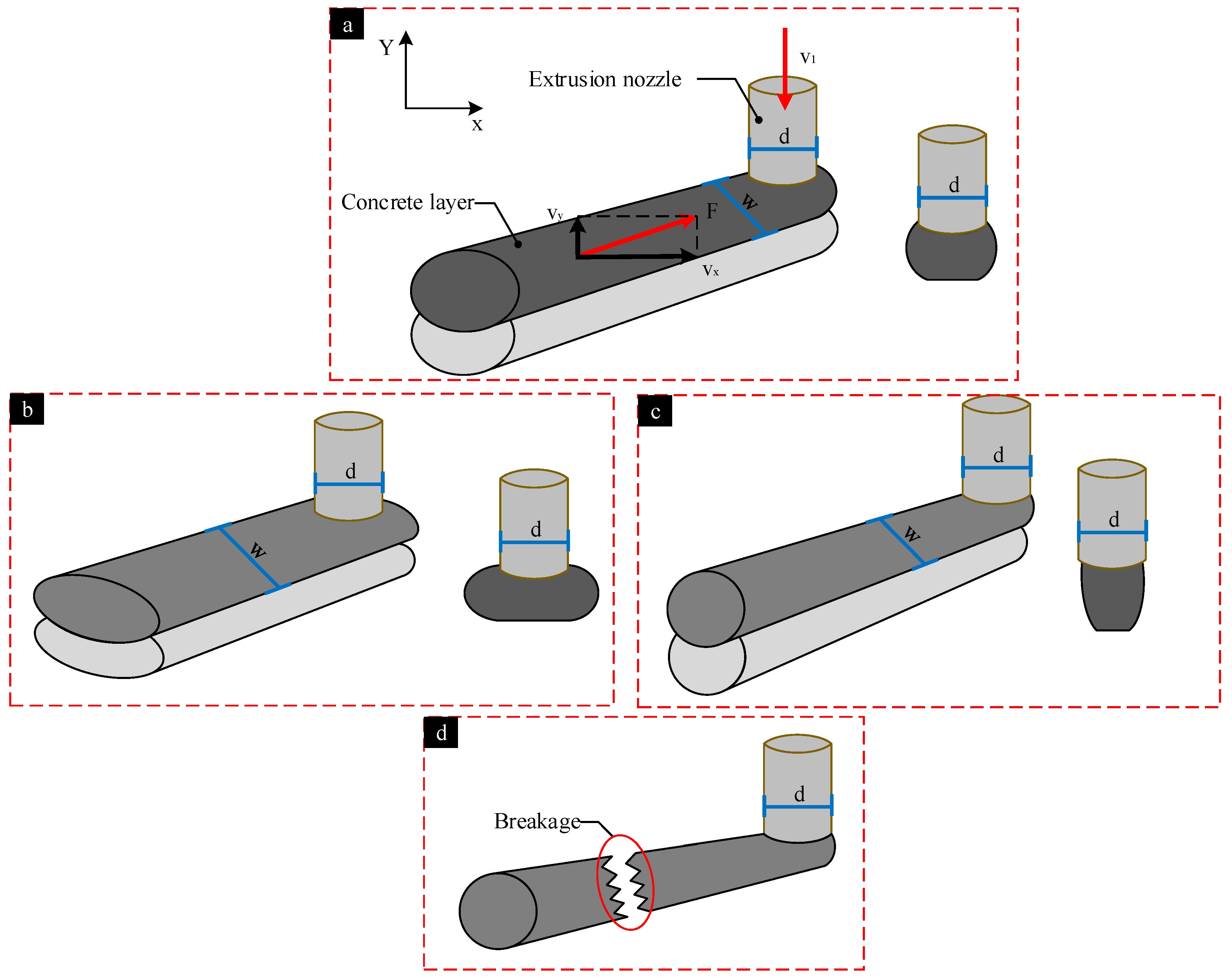


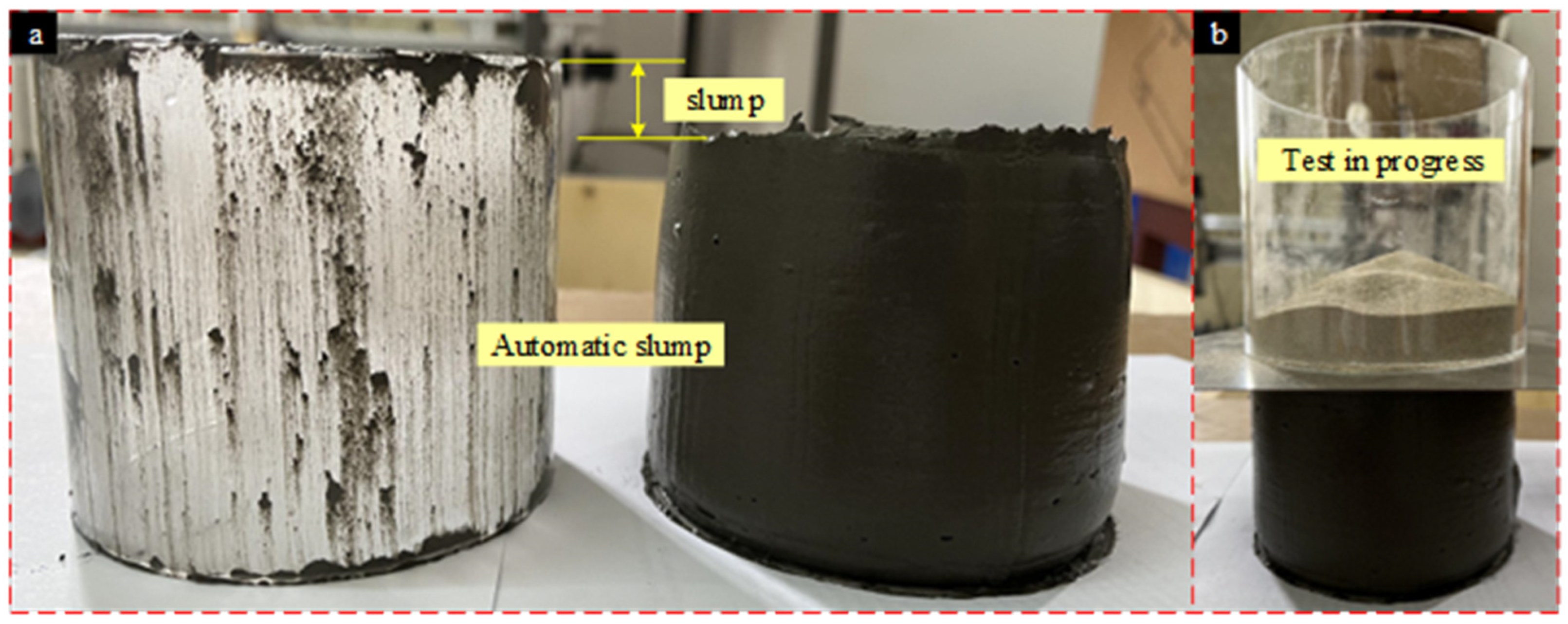
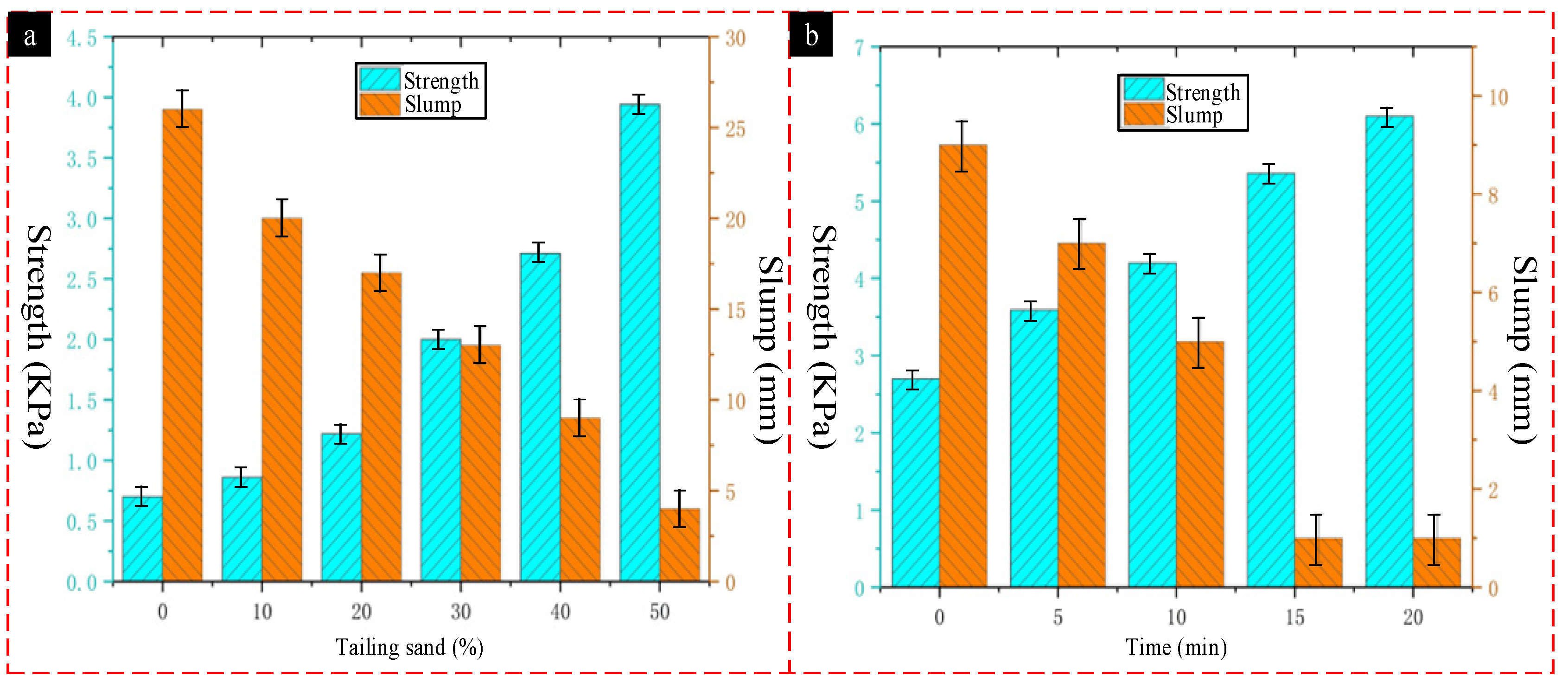
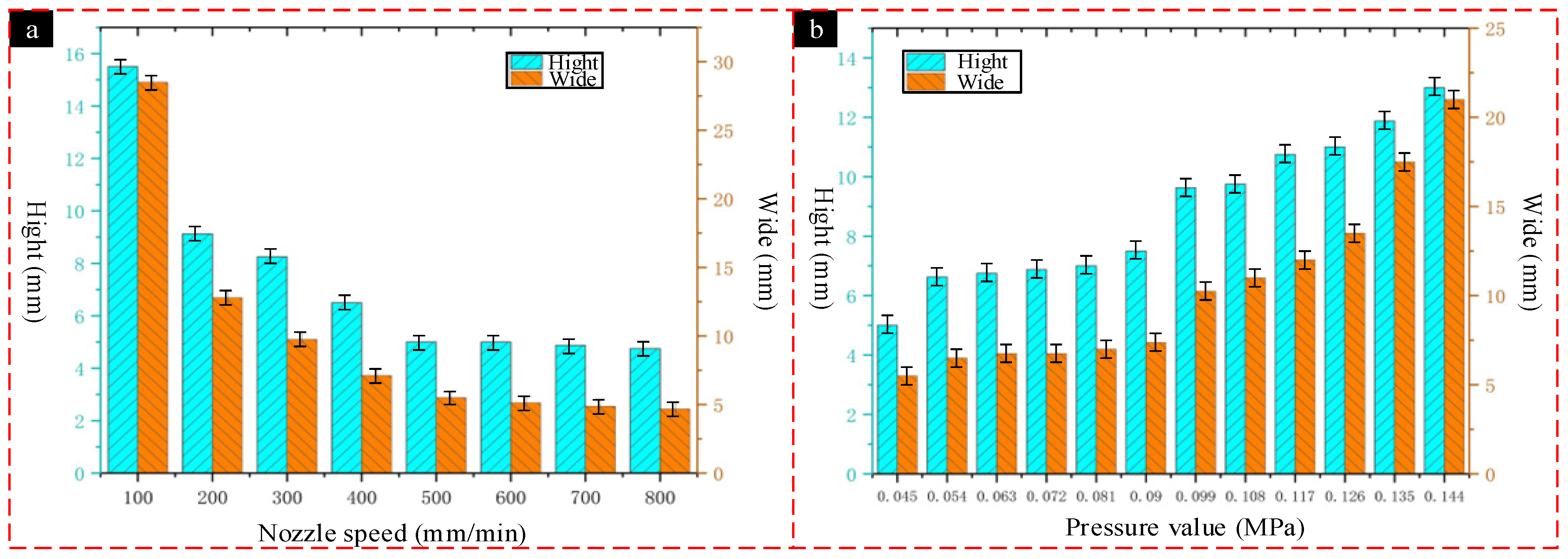
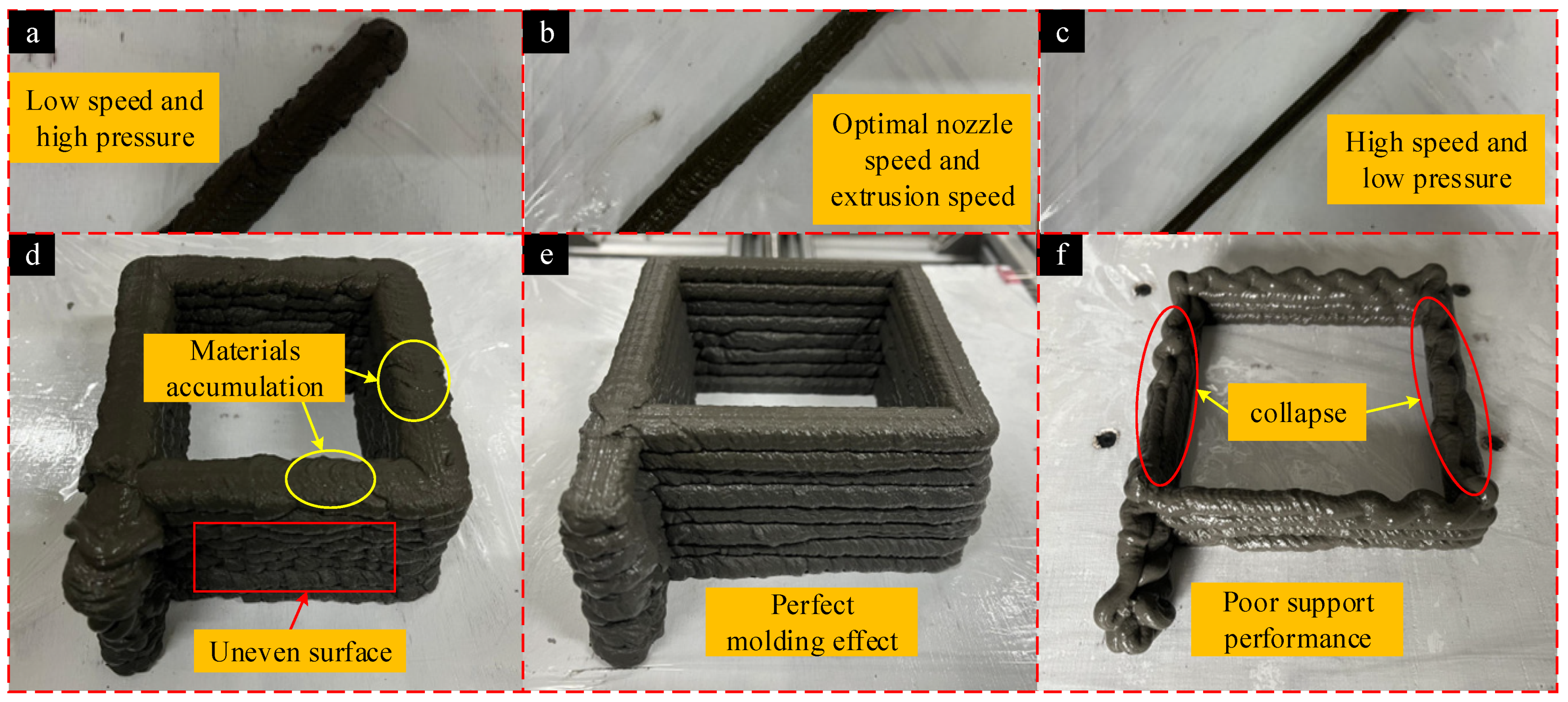
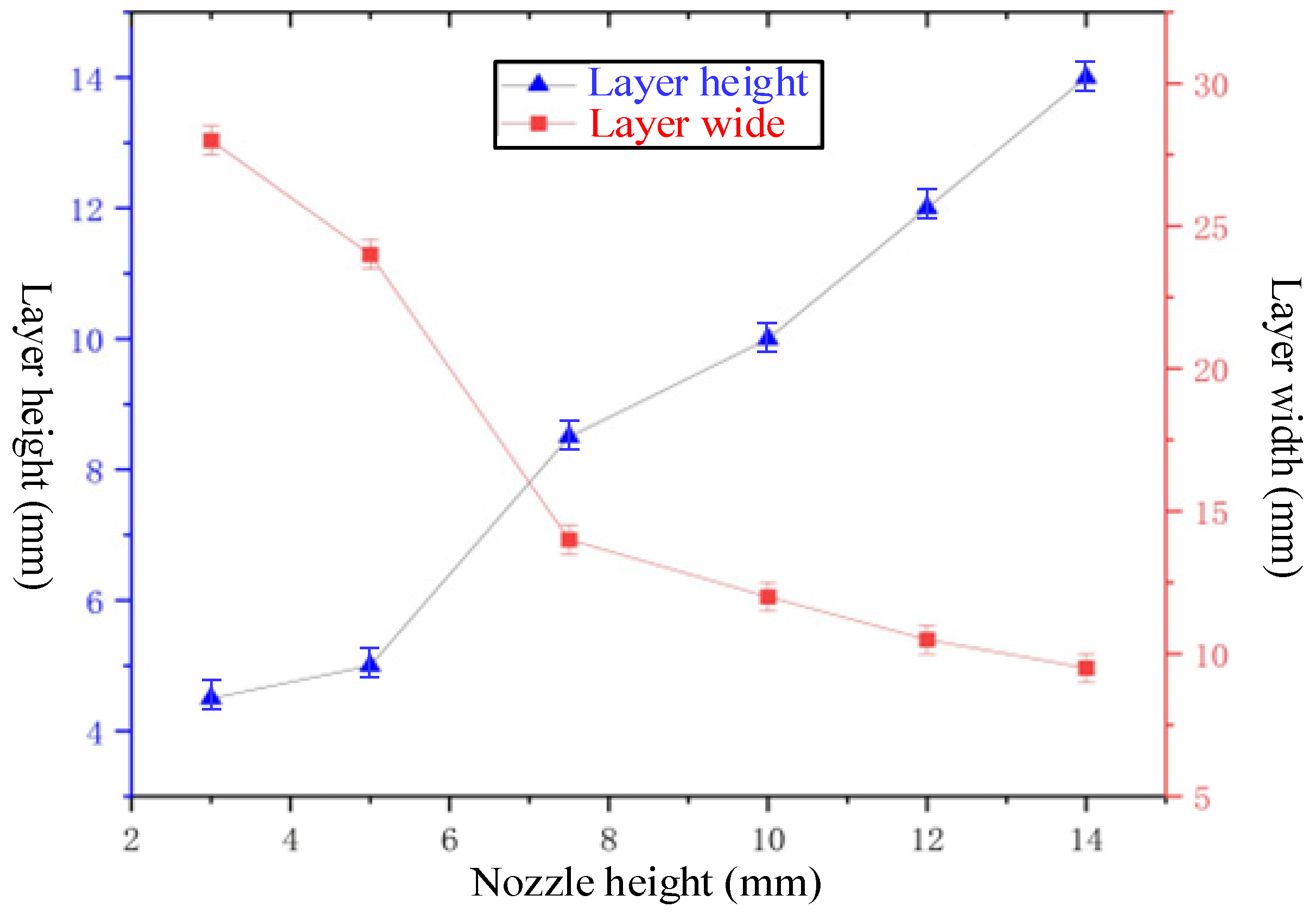
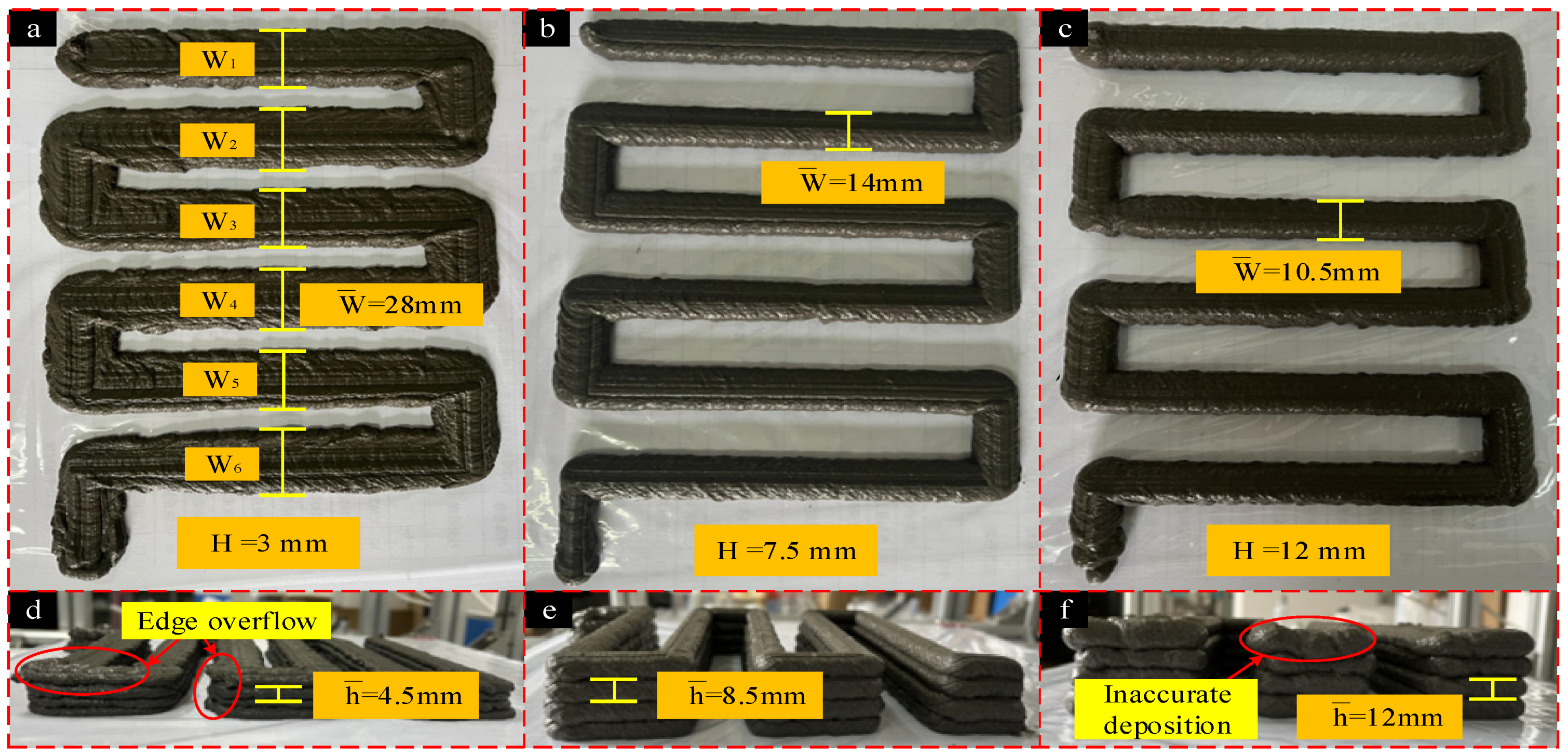
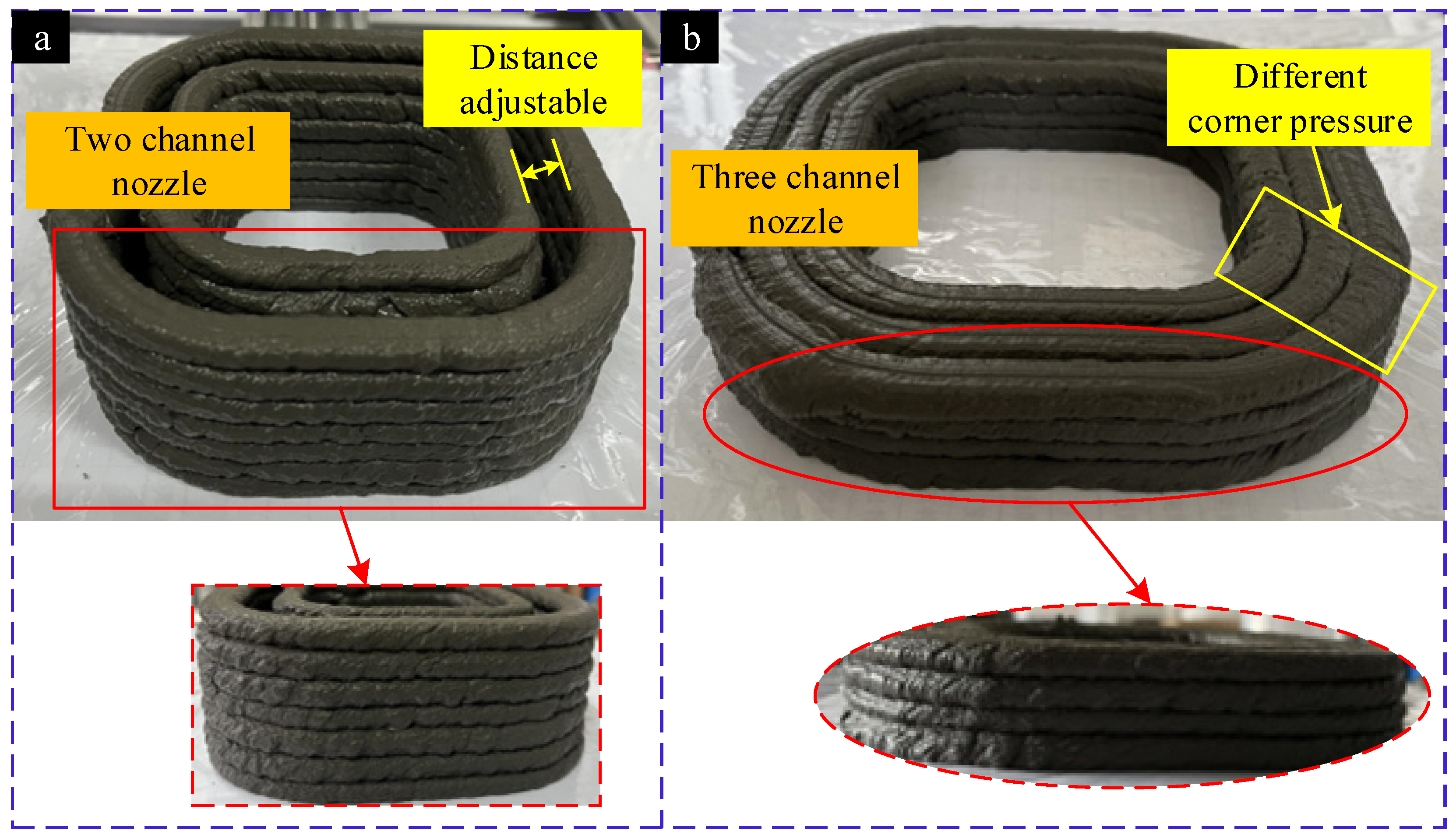
| Fine Aggregate | Fineness Modulus | Average Particle Size (mm) | Bulk Density (kg/m3) | Mud Content (%) |
|---|---|---|---|---|
| Tailing sand | 0.7 | 0.15 | 1400 | 0.4 |
| Admixture | Fineness (45 micron standard sieve) | Average particle size (µm) | Density (g/cm3) | Water content (%) |
| Fly ash | ≤5% | 5 | 2.6 | ≤1 |
| Slag powder | ≤3% | 38 | 2.8 | ≤1 |
| Silicon powder | ≤3% | 5 | 2.6 | ≤3 |
| Tailing Sand/% | Water/Cement Ratio | Cement/% | Mineral Admixture/% | Thickener/% | Retarder/% |
|---|---|---|---|---|---|
| 0 | 0.39 | 80.2 | 19.8 | 0.05 | 0.3 |
| 10 | 0.39 | 80.2 | 19.8 | 0.05 | 0.3 |
| 20 | 0.39 | 80.2 | 19.8 | 0.05 | 0.3 |
| 30 | 0.39 | 80.2 | 19.8 | 0.05 | 0.3 |
| 40 | 0.39 | 80.2 | 19.8 | 0.05 | 0.3 |
| 50 | 0.39 | 80.2 | 19.8 | 0.05 | 0.3 |
| Parameters | Value |
|---|---|
| Size specification (X × Y × Z) | 800 × 800 × 600 mm3 |
| Walking accuracy | ±1 mm |
| Print speed | 0–3000 mm/min |
| Pressure range | 0–1.0 MPa |
| Number | Nozzle Speed (mm/s) | Pressure Value (MPa) | Number | Nozzle Speed (mm/s) | Pressure Value (MPa) |
|---|---|---|---|---|---|
| 1 | 1.667 | 0.045 | 5 | 8.333 | 0.045 |
| 2 | 3.333 | 0.045 | 6 | 10 | 0.045 |
| 3 | 5 | 0.045 | 7 | 11.667 | 0.045 |
| 4 | 6.667 | 0.045 | 8 | 13.333 | 0.045 |
| Number | Pressure Value (MPa) | Nozzle Speed (mm/s) | Number | Pressure Value (MPa) | Nozzle Speed (mm/s) |
|---|---|---|---|---|---|
| 1 | 0.045 | 8.333 | 7 | 0.099 | 8.333 |
| 2 | 0.054 | 8.333 | 8 | 0.108 | 8.333 |
| 3 | 0.063 | 8.333 | 9 | 0.117 | 8.333 |
| 4 | 0.072 | 8.333 | 10 | 0.126 | 8.333 |
| 5 | 0.081 | 8.333 | 11 | 0.135 | 8.333 |
| 6 | 0.09 | 8.333 | 12 | 0.144 | 8.333 |
| Number | Nozzle Offset (mm) | Nozzle Diameter (mm) | Number | Nozzle Offset (mm) | Nozzle Diameter (mm) |
|---|---|---|---|---|---|
| 1 | 3 | 10 | 4 | 10 | 10 |
| 2 | 5 | 10 | 5 | 12 | 10 |
| 3 | 7.5 | 10 | 6 | 14 | 10 |
Publisher’s Note: MDPI stays neutral with regard to jurisdictional claims in published maps and institutional affiliations. |
© 2022 by the authors. Licensee MDPI, Basel, Switzerland. This article is an open access article distributed under the terms and conditions of the Creative Commons Attribution (CC BY) license (https://creativecommons.org/licenses/by/4.0/).
Share and Cite
Li, Z.; Liu, H.; Cheng, X.; Nie, P.; Yang, X.; Zheng, G.; Su, H.; Jin, W. Improvement of 3D Printing Cement-Based Material Process: Parameter Experiment and Analysis. Coatings 2022, 12, 1973. https://doi.org/10.3390/coatings12121973
Li Z, Liu H, Cheng X, Nie P, Yang X, Zheng G, Su H, Jin W. Improvement of 3D Printing Cement-Based Material Process: Parameter Experiment and Analysis. Coatings. 2022; 12(12):1973. https://doi.org/10.3390/coatings12121973
Chicago/Turabian StyleLi, Zihan, Huanbao Liu, Xiang Cheng, Ping Nie, Xianhai Yang, Guangming Zheng, Hongxing Su, and Wenyu Jin. 2022. "Improvement of 3D Printing Cement-Based Material Process: Parameter Experiment and Analysis" Coatings 12, no. 12: 1973. https://doi.org/10.3390/coatings12121973





